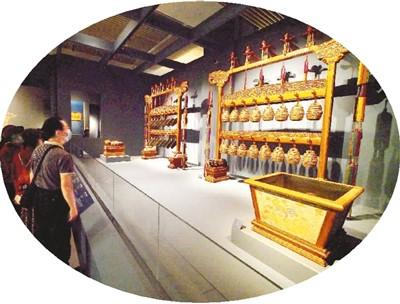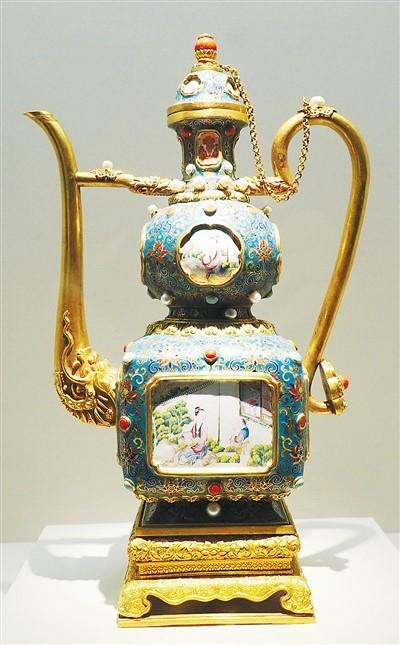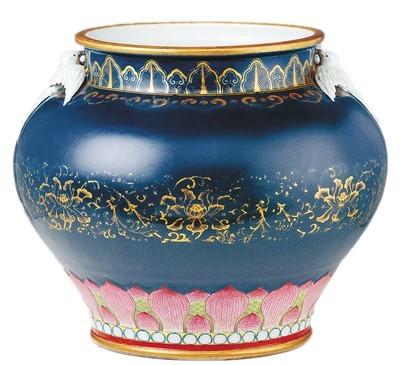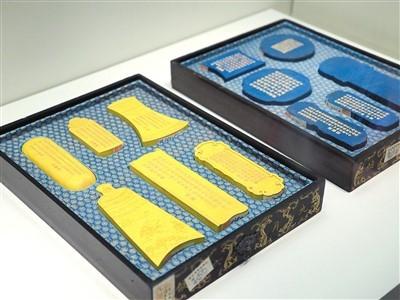Source: People’s Daily Online-People’s Daily Overseas Edition

The audience enjoyed the "Zhonghe Shaole" musical instrument in Qing Dynasty. Du Jianpo

Qing gan long Jin tai enamel figure holding pot Du Jianpo

Qing gan long Ji Qing Jin Cai hai Yan he Qing Zun Photo courtesy of Guobo

Qing Qianlong’s "seventy-two poems on the imperial month" is colored ink (September and October). Du Jianpo
From ancient stone tools, bone implements, jade articles and pottery to colorful export porcelain and finely carved lacquerware, from the silk painting "Fuxi Nu Wa Tu" drawn by the Tang Dynasty to the Tao Te Ching written by the calligrapher in fine small letters in the Yuan Dynasty … into the China National Museum "Harmony and Symbiosis-the Forbidden City-Guobo Tibetan Cultural Relics Joint Exhibition", rich cultural relics show the long history of Chinese civilization.
This exhibition is the first heavy special exhibition jointly launched by the Palace Museum and the National Museum of China. More than 400 cultural relics are selected from the rich collections of the Palace Museum and Guobo for display. The exhibition is divided into four units, which expounds the historical origin and rich connotation of China’s "harmony" culture from four aspects: the universe, the world, society and morality. The first unit, "Harmony between Heaven and Earth", explains the cosmology of the unity of heaven and man advocated by the Chinese nation since ancient times; The second unit, "Harmony among All Nations", explains the world view of harmony among all nations upheld by the Chinese nation when dealing with foreign relations; The third unit, "Yi Min An He", explains Chinese civilization’s respect and tolerance for the cultural diversity of all social strata and ethnic groups. The fourth unit, "Happiness lies in harmony with people", explains the moral concept of "people’s hearts are kind" of the Chinese nation.
Wisdom of the Unity of Heaven and Man
Stepping into the exhibition hall, the jade ritual vessels of Hongshan culture Yulong, Liangzhu culture Jade Cong and Qijia culture Jade Bi attracted the audience to stop and enjoy. Chinese ancestors collected natural jade and carefully crafted it into a ritual vessel to communicate with heaven and earth and offer sacrifices to ancestors. Today, thousands of years later, when we see these jade articles, we will still be amazed by the superb carving skills and rich imagination of our ancestors.
From chiseling stone, grinding bone and reeling silk to making pottery, smelting copper and painting lacquer, the ancients had a deeper and more comprehensive understanding of the development and utilization of natural materials and the laws of nature, and the emotional resonance and aesthetic concepts caused by natural phenomena were gradually integrated into labor practice and material creation, thus forming a unique ritual and music civilization and social system of the Chinese nation.
In ancient times, the ancestors in the middle and lower reaches of the Yellow River summed up the laws of natural changes according to the climate and four seasons alternately, so as to guide daily life and realize the progress of productive forces. Monthly order, that is, taking the four seasons as the general outline and December as the details, records the astronomical calendar and natural phenology in time, and arranges the decrees of production and life accordingly. In the exhibition hall, Qingganlong’s "Poems of seventy-two waiting for the moon" is the embodiment of the cultural tradition of "obeying the weather and responding to the times". This ink set consists of two boxes, with 6 drawers in each box and 6 spindles in each drawer, totaling 72 spindles. One spindle of ink corresponds to a phenology, with different sizes and shapes, including round, oval, square, hexagonal, leaf, tablet, harp and bell. Ink colors are divided into green, red, white, blue and yellow, which correspond to the traditional five elements in China: spring (first month and February) is wood, which corresponds to green; Summer (April and May) is fire, corresponding to red; Autumn (July and August) is gold, corresponding to white; Winter (October and November) is water, corresponding to blue; The turn of the two seasons (March, June, September and December) is earth, which means activation and hair growth, corresponding to yellow.
Next to the moon-colored ink, there is a set of poems cups with colorful December flowers in Qing Kangxi. This set of multicolored cups consists of 12 pieces. The bright white glaze is decorated with blue and white multicolored flowers. On the one hand, the representative flowers of each month are painted, and on the other hand, the poems corresponding to the flowers are inscribed. Most of the poems are taken from The Whole Tang Poetry. This set of porcelain cups belongs to the imperial wine glasses, with thin and light tires, beautiful patterns and neat styles, which represents the highest level of making blue and white multicolored thin-shell porcelain in Jingdezhen Imperial Kiln Factory in Kangxi Dynasty.
On the one hand, there are bronze bells, chimes and cymbals in the Spring and Autumn Period and the Warring States Period, and on the other hand, there is the glittering "Zhonghe Shaole" musical instrument in the Qing Dynasty. The two sets of exhibits reflect the inheritance and development of Chinese ritual and music culture for thousands of years. Elegant music is the orthodox music used in ancient China to worship heaven and earth, ancestors, and banquets. Its system was formulated in the early years of the Western Zhou Dynasty. The main musical instruments of ancient elegant music are chimes and chimes. The music begins with a bronze bell and ends with a jade chime, which is a combination of many voices and symbolizes "golden sound and jade vibration". "Zhonghe Shaole" has the highest specification in the music system of Ming and Qing Dynasties, and is mainly used for altar and temple sacrifices and national ceremonies above Zhongsi. The bronze-gilded chime with double dragons and dragons’ buttons and dragons’ patterns made during the reign of Emperor Qianlong of Qing Dynasty was hung on the shelf carved with dragons and painted with gold in two layers, showing its dignity and elegance. Matching with it, the jadeite-painted plait with Un-yong Kim pattern is made of precious jade from Hetian, Xinjiang, and both sides of the chime are decorated with Un-yong Kim pattern. The golden yellow of the gold-painted pattern and the emerald green of the jade are brilliant.
Openness and tolerance
In the independent showcase, a small seal on one side evokes people’s reverie of desert wind and smoke and camel bells. This lute was unearthed from Zhang Qian’s tomb in Chenggu County, Shaanxi Province, and the front is engraved with the words "Bowang-Zao" in Yang. During the period of Emperor Wu of the Han Dynasty, Zhang Qian was ordered to make two missions to the Western Regions, which opened up the world-famous Silk Road and was named Bo Wanghou.
The brocade of the Tang Dynasty with decorative group patterns, knight patterns and pig head patterns tells the story of increasing prosperity after the Silk Road was opened for thousands of years. The exotic patterns are integrated with the traditional auspicious patterns in the Central Plains, presenting an open, inclusive and colorful prosperous scene.
Painted porcelain from Changsha kiln in the Tang Dynasty, celadon from Longquan kiln in the Yuan Dynasty, blue-and-white porcelain from Jingdezhen kiln in the Ming Dynasty, and wide-colored porcelain in the Qing Dynasty … Famous export porcelain products of past dynasties witnessed the prosperity of the Maritime Silk Road. A green glazed phoenix tail statue of Longquan kiln with elegant shape and exquisite decoration attracted the reporter’s attention. This statue has a long neck, rich shoulders, and gradually converges below the abdomen, slightly skimming near the foot and circling the foot. Thick blue glaze is applied inside and outside the porcelain, and the glaze is open. The neck is carved with dense chords, the upper abdomen is carved with branches-bound peony, and the lower abdomen is carved with chrysanthemum petals. According to reports, in a Yuan Dynasty shipwreck full of ceramics in Xin ‘an sea area, South Korea, a phoenix-tailed statue with green glaze and peony pattern in Longquan kiln was found, which proved that Longquan kiln celadon played an important role in the cultural exchange and trade of the Maritime Silk Road in Yuan Dynasty.
Corresponding to these export porcelains, overseas countries learn from China’s porcelain-making technology to produce porcelains. For example, Koryo celadon in the 12th century, Jingdezhen multicolored porcelain imitated by Maisen kiln in Europe in the 18th century, and Dehua kiln white porcelain imitated by Japan in the 19th century. These foreign porcelain products have flowed into China and entered the palace, which has become a much-told story for the exchange and mutual learning between Chinese and foreign civilizations.
Passing through a porch that imitates the panorama of the Forbidden City, a series of exhibits come into view, which reflect the achievements of innovation and development after the introduction of western culture into China. The figurines of the Qing-Gan-Long Golden Fetus Enamel are combined with many techniques such as inlay, engraving, silk-twisting enamel and painting enamel, which are exquisite and amazing. This pot is made of gold, and its shape is gourd-shaped. The whole body is painted with blue enamel, decorated with twisted silk and lotus patterns, and inlaid with pearls and corals in many places. Painted enamels with different sizes and shapes are symmetrically arranged on the lid, neck, lower abdomen and large abdomen, and figures, flowers and courtyard landscapes are painted inside the enamel. Under it, it is equipped with a lotus-carved gold-plated copper seat. Cloisoned enamel and painted enamel are all imported from the west. During Qianlong period, there were few figures decorated in enamel products, so this device can be called a masterpiece. The ladies and courtyard figures painted in the opening of the vessel are traditional paintings in China, but they are expressed by European techniques, which reflects the artistic style of combining Chinese and Western styles.
The morality of harmony and goodness
The third unit of the exhibition presents a picture of the harmonious coexistence of scholars, agriculture, industry and commerce in ancient China. "Han Bao Sai Wu Huan leads many leaders" camel button bronze seal is the official seal awarded by the Eastern Han Dynasty court to the leaders of Wu Huan nationality. Wuhuan is a branch of Donghu people in ancient China. The title of "leading the crowd" is related to his deeds such as leading the crowd to join, guarding the frontier fortress, helping the war and counterinsurgency. Cultural relics with national characteristics, such as the bronze musical instruments of southwest nationalities in Han Dynasty, the jade carvings of "Spring Water" and "Autumn Mountain" in Jin Dynasty, and the "Gong Gong Tu" in Ming and Qing Dynasties, reflect the colorful national culture.
The Southern Tour of Qianlong is a huge historical picture of Qing Dynasty painter Xu Yang’s first southern tour of Jiangsu and Zhejiang in 1751 with "imperial poetry as the picture". The whole picture consists of 12 volumes, which combines poetry, calligraphy and painting, and realistically depicts the scene of Qianlong’s early trip to the south of the Yangtze River, the province asking for customs, inspecting officials and the people, inspecting river workers, reviewing divisions and brigades, offering sacrifices to Yuling and visiting scenic spots in lakes and mountains, which truly reflects the splendid rivers and mountains and social features. In this exhibition, the sixth volume of the Southern Tour of Qianlong was exhibited. This volume is entitled "Zhu Gu Su", which focuses on the landscape from Changmen to Xumen in Suzhou. The whole painting takes the Grand Canal as the main axis, with houses and shops along the banks of the river, which is full of prosperity and prosperity.
The foundation of a harmonious society is the values of "people are kind" and "harmony is the most important". Ming Xianzong Zhu Jianshen painted the axis of "A Harmony Map", depicting three old people huddled together, with the old man on the left wearing a Taoist crown, the old man in the middle dressed as a monk, and a Confucian scholar wearing a square towel on the right. The composition of the whole work is ingenious, and it looks like a smiling Maitreya sitting cross-legged, beaming and harmonious, showing the thought of the unity and harmonious blending of Confucianism, Buddhism and Taoism.
At the end of the exhibition, a piece of green and golden colors, Haiyan River, attracted people’s attention. The outer wall of this device is painted with blue enamel, with gold-painted branches-bound peony, banana leaf pattern, ruyi cloud pattern, etc., and near the foot is decorated with pastel lotus pattern and lotus bead pattern, and a pair of white swallows with wings spread and tails cut are carved between the shoulders and necks as ears. This porcelain statue was fired by Jingdezhen Imperial Kiln in the Qing Dynasty for Haiyan Hall in Yuanmingyuan. It needs to be put into the kiln and painted many times, and its technology is superb, which is a combination of carving, pasting and embossing. The blue color of this statue symbolizes "Heqing", and Yan is homophonic with "Yan", which means that Haiyan River is clear and the world is peaceful.
关于作者